Classical Music 1750 — 1800 Higher Music

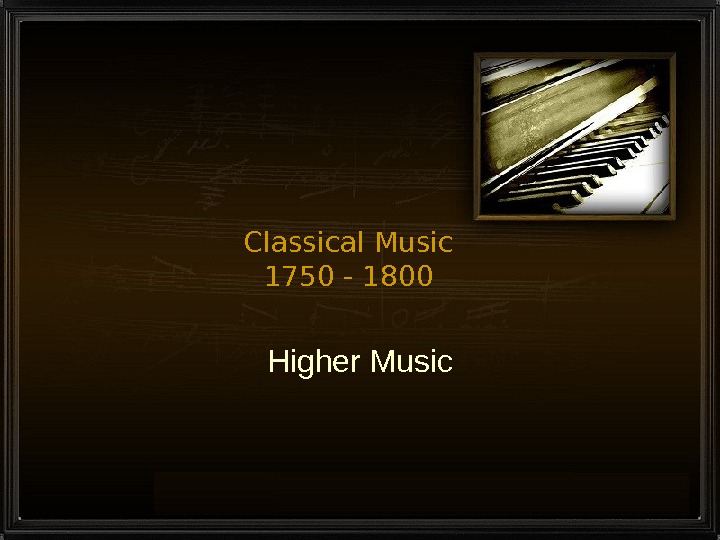
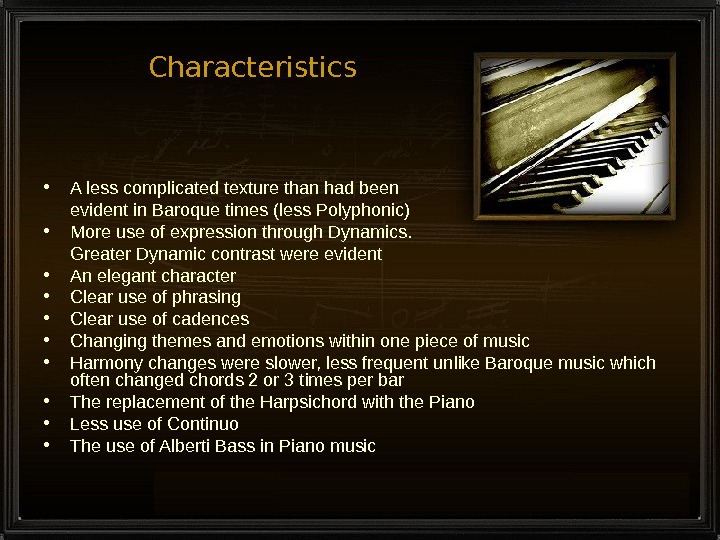
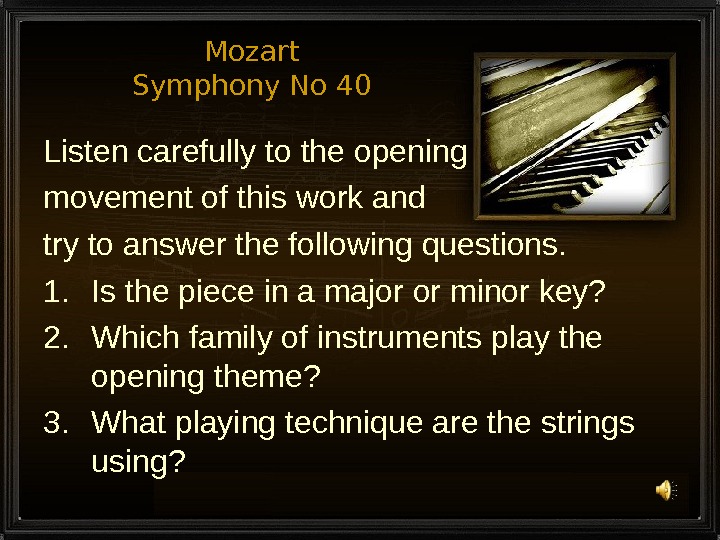
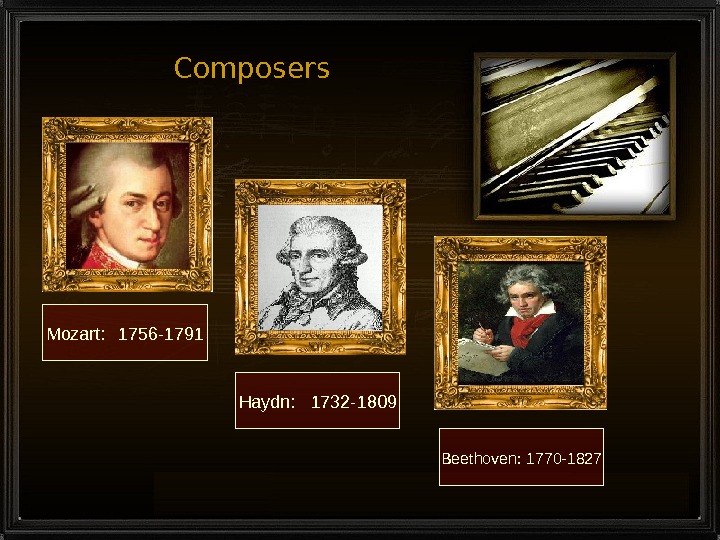
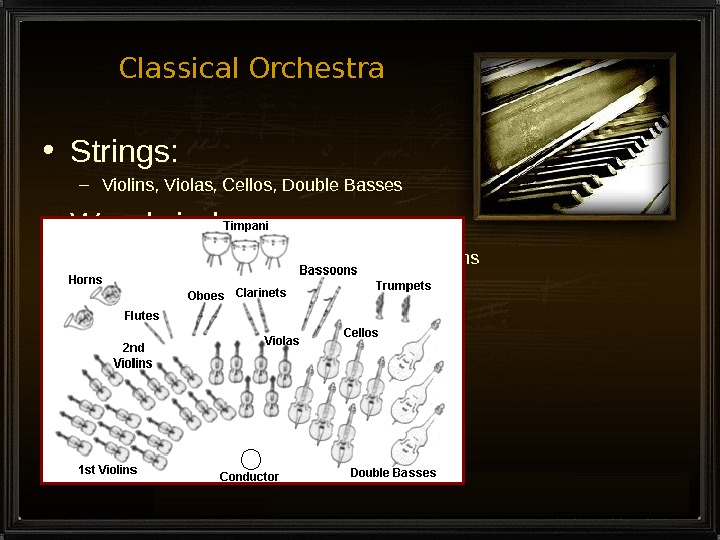
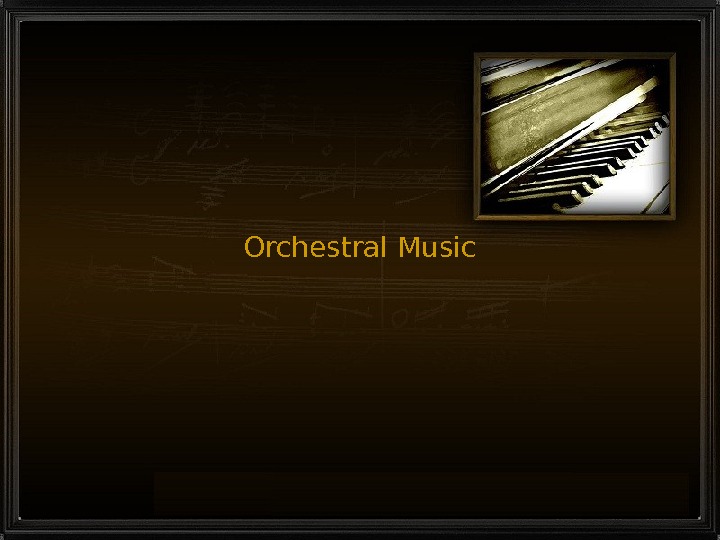
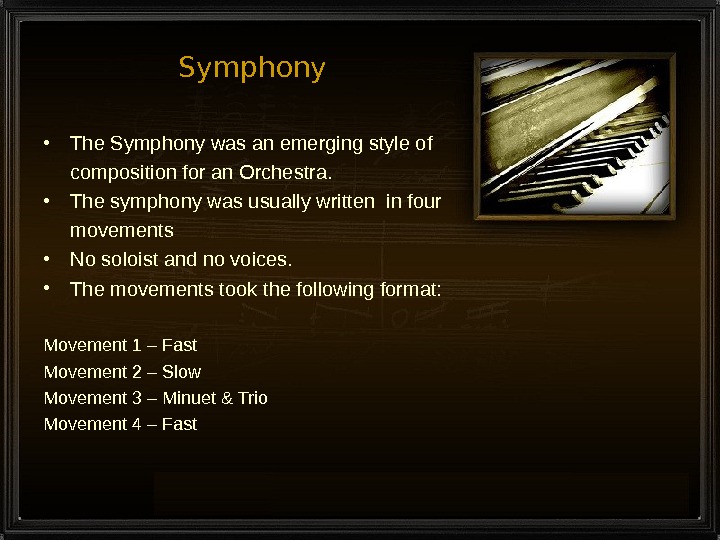

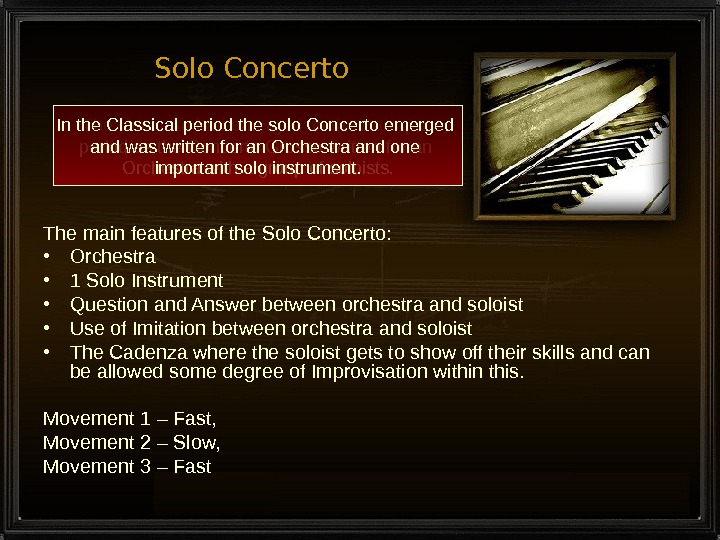
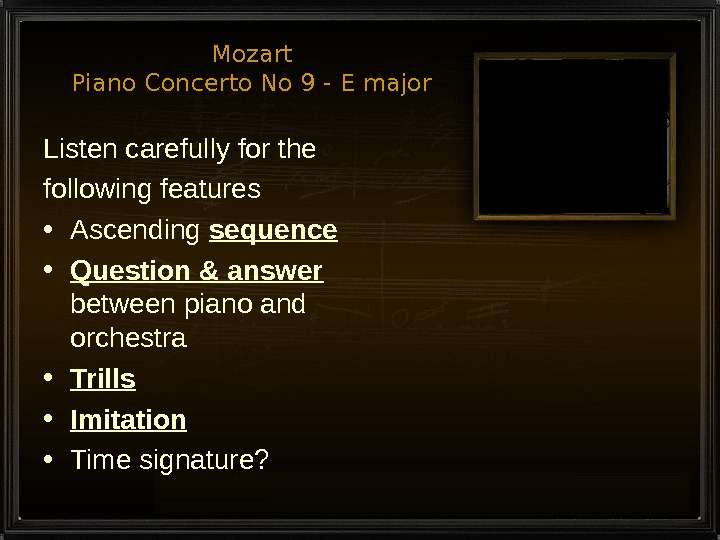

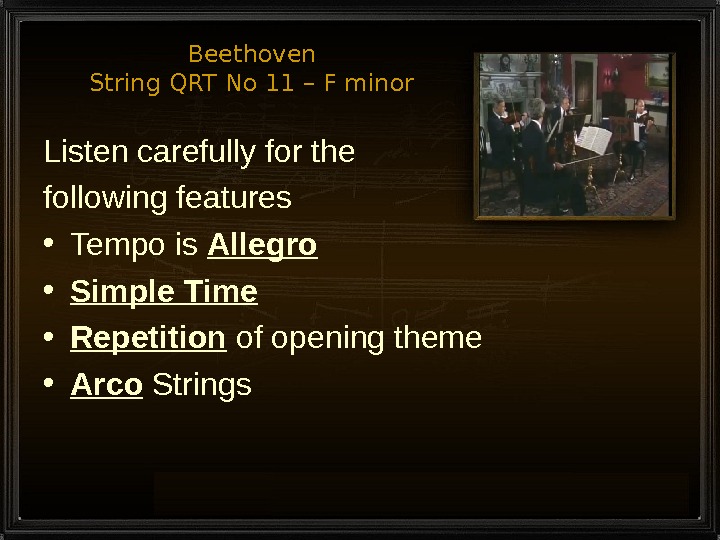
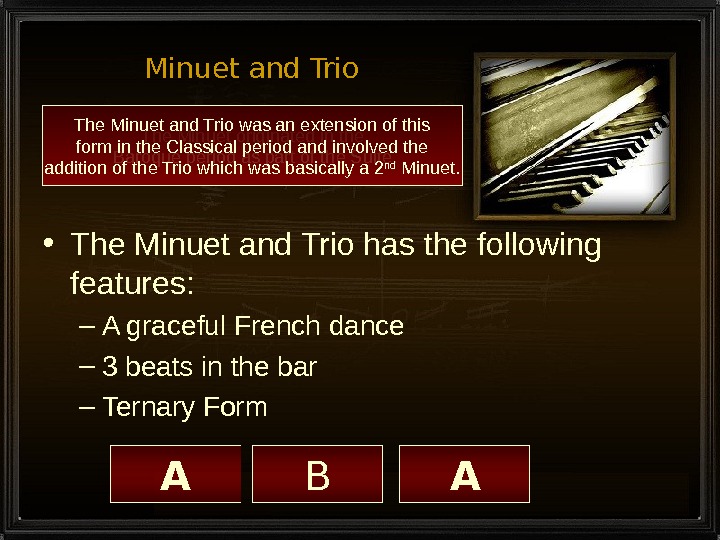
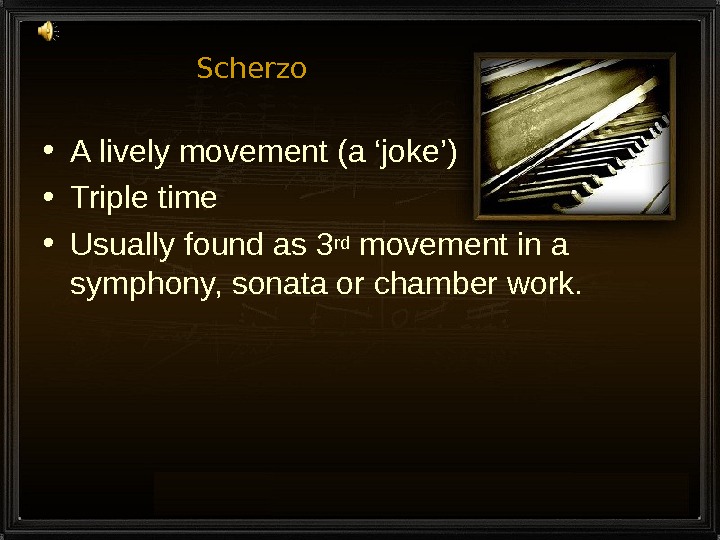
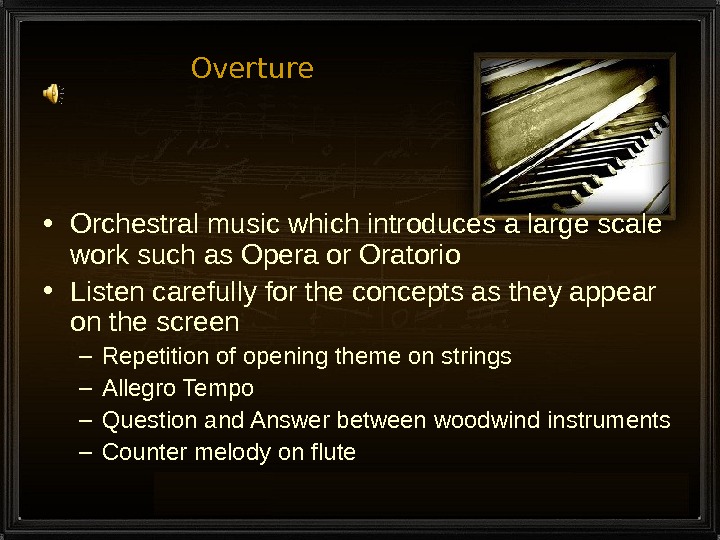
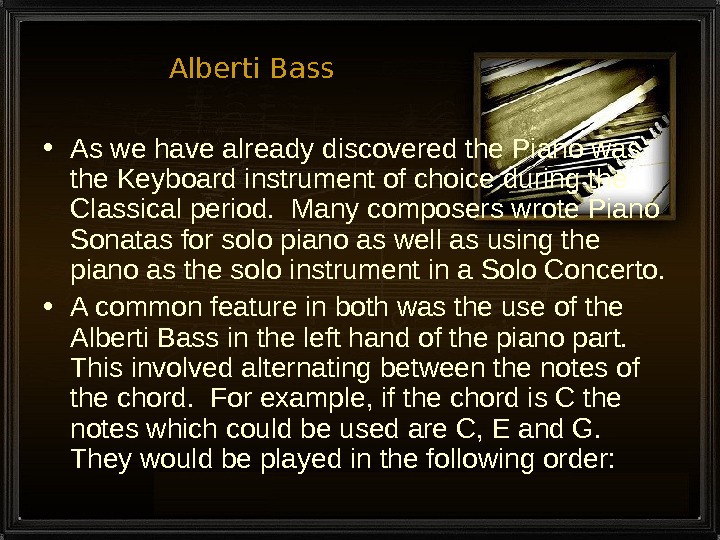
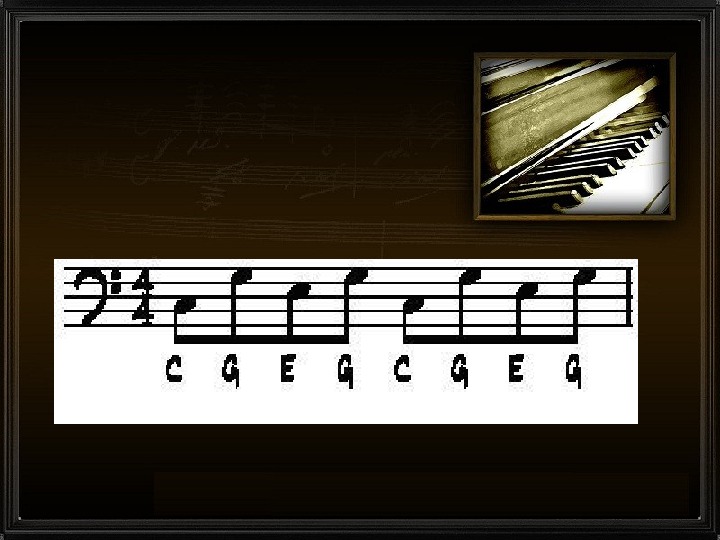
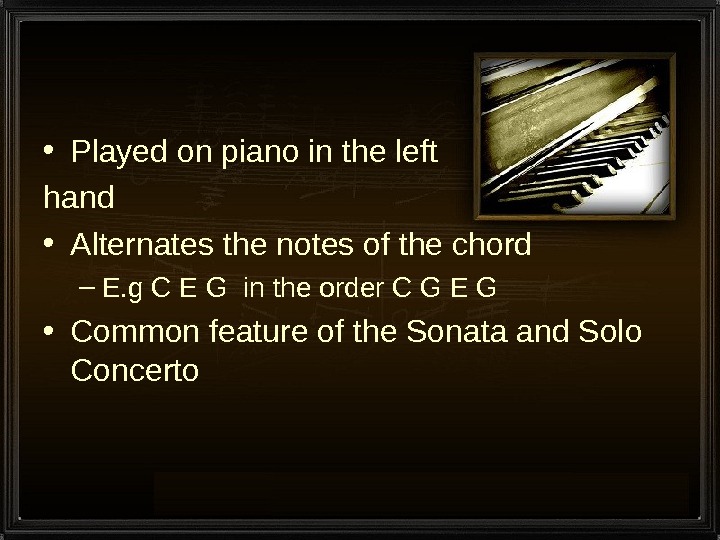
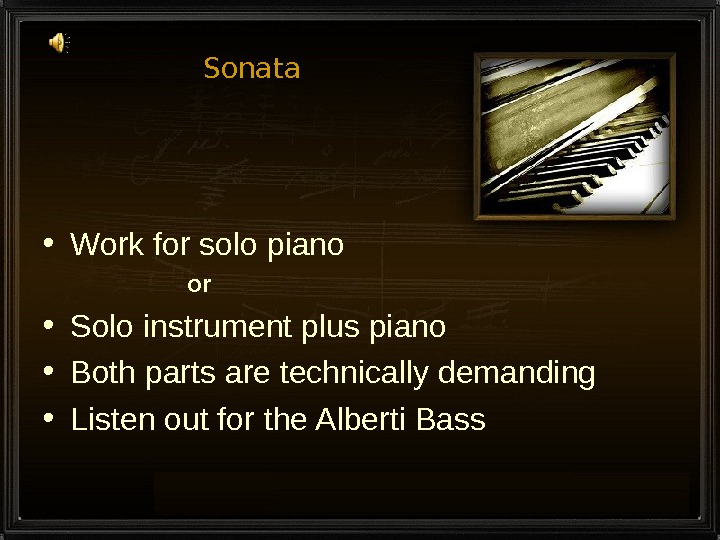
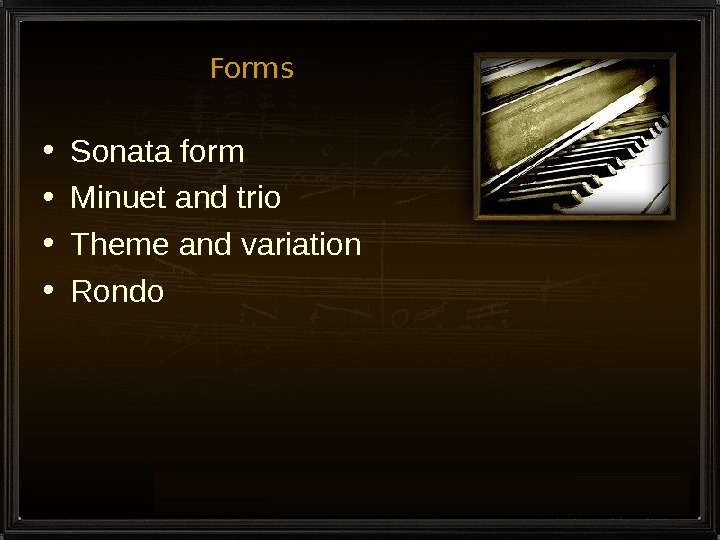
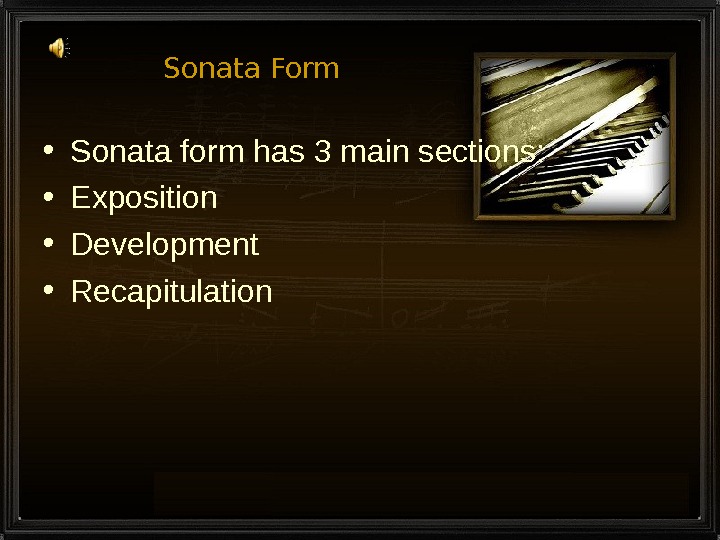

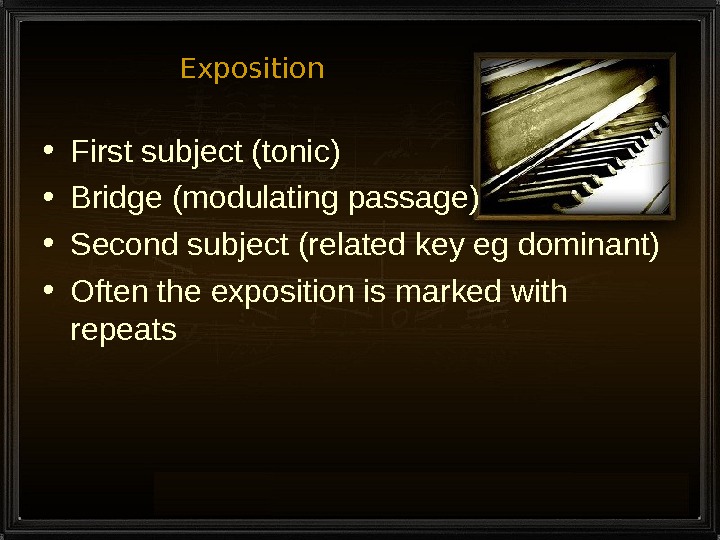
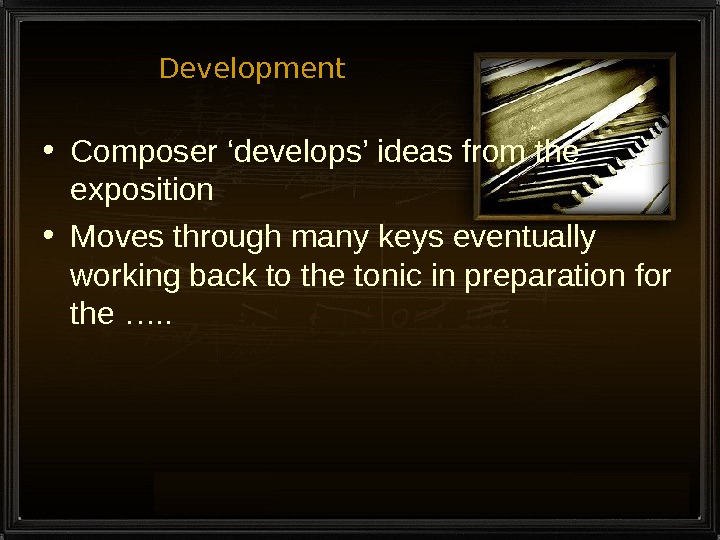
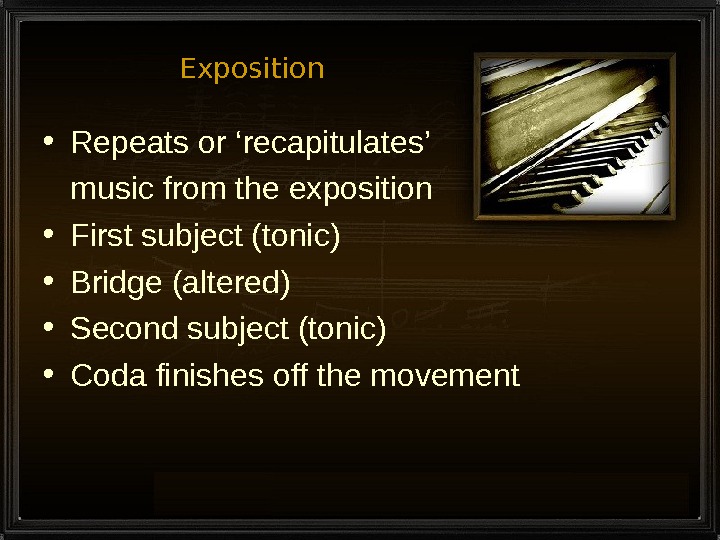
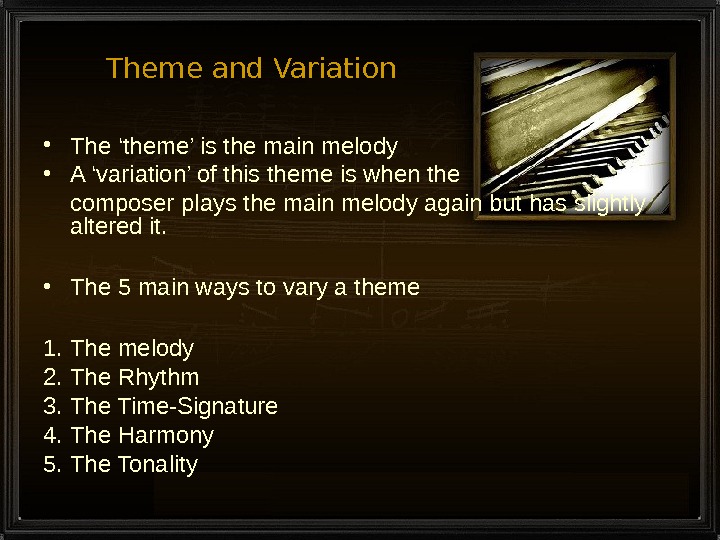
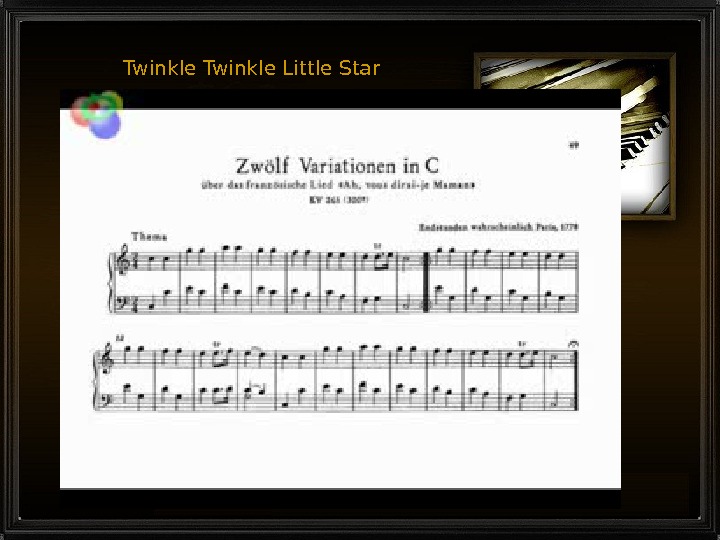
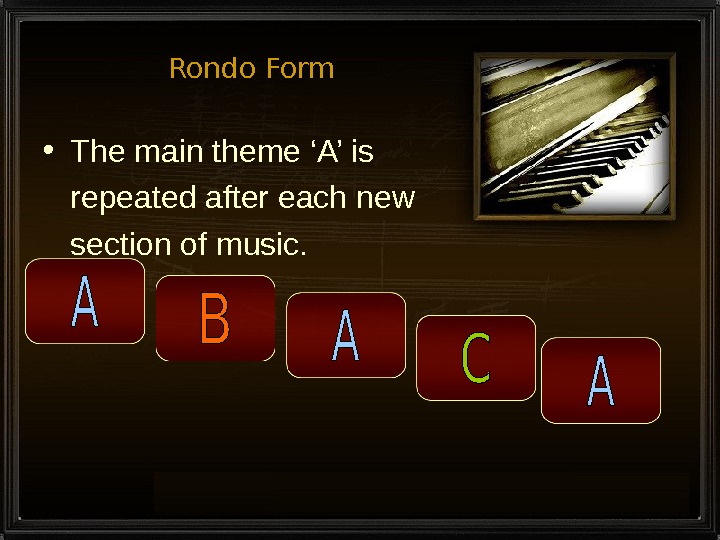
- Размер: 1.4 Mегабайта
- Количество слайдов: 28
Описание презентации Classical Music 1750 — 1800 Higher Music по слайдам
 Classical Music 1750 — 1800 Higher Music
Classical Music 1750 — 1800 Higher Music
 Characteristics • A less complicated texture than had been evident in Baroque times (less Polyphonic) • More use of expression through Dynamics. Greater Dynamic contrast were evident • An elegant character • Clear use of phrasing • Clear use of cadences • Changing themes and emotions within one piece of music • Harmony changes were slower, less frequent unlike Baroque music which often changed chords 2 or 3 times per bar • The replacement of the Harpsichord with the Piano • Less use of Continuo • The use of Alberti Bass in Piano music
Characteristics • A less complicated texture than had been evident in Baroque times (less Polyphonic) • More use of expression through Dynamics. Greater Dynamic contrast were evident • An elegant character • Clear use of phrasing • Clear use of cadences • Changing themes and emotions within one piece of music • Harmony changes were slower, less frequent unlike Baroque music which often changed chords 2 or 3 times per bar • The replacement of the Harpsichord with the Piano • Less use of Continuo • The use of Alberti Bass in Piano music
 Mozart Symphony No 40 Listen carefully to the opening movement of this work and try to answer the following questions. 1. Is the piece in a major or minor key? 2. Which family of instruments play the opening theme? 3. What playing technique are the strings using?
Mozart Symphony No 40 Listen carefully to the opening movement of this work and try to answer the following questions. 1. Is the piece in a major or minor key? 2. Which family of instruments play the opening theme? 3. What playing technique are the strings using?
 Composers Mozart: 1756 -1791 Haydn: 1732 -1809 Beethoven: 1770 —
Composers Mozart: 1756 -1791 Haydn: 1732 -1809 Beethoven: 1770 —
 Classical Orchestra • Strings: – Violins, Violas, Cellos, Double Basses • Woodwind: – 1 or 2 Flutes, 2 Oboes, 2 Clarinets, 2 Bassoons • Brass: – 2 Horns, 2 Trumpets • Percussion: – 2 Timpani, Piano
Classical Orchestra • Strings: – Violins, Violas, Cellos, Double Basses • Woodwind: – 1 or 2 Flutes, 2 Oboes, 2 Clarinets, 2 Bassoons • Brass: – 2 Horns, 2 Trumpets • Percussion: – 2 Timpani, Piano
 Orchestral Music
Orchestral Music
 Symphony • The Symphony was an emerging style of composition for an Orchestra. • The symphony was usually written in four movements • No soloist and no voices. • The movements took the following format: Movement 1 – Fast Movement 2 – Slow Movement 3 – Minuet & Trio Movement 4 – Fast
Symphony • The Symphony was an emerging style of composition for an Orchestra. • The symphony was usually written in four movements • No soloist and no voices. • The movements took the following format: Movement 1 – Fast Movement 2 – Slow Movement 3 – Minuet & Trio Movement 4 – Fast
 Haydn Symphony No 104 – D major Listen carefully for the following features • Timpani rolls at beginning • Arco Strings • Question and Answer • Contrasting dynamics • Repetition of theme
Haydn Symphony No 104 – D major Listen carefully for the following features • Timpani rolls at beginning • Arco Strings • Question and Answer • Contrasting dynamics • Repetition of theme
 Solo Concerto The main features of the Solo Concerto: • Orchestra • 1 Solo Instrument • Question and Answer between orchestra and soloist • Use of Imitation between orchestra and soloist • The Cadenza where the soloist gets to show off their skills and can be allowed some degree of Improvisation within this. Movement 1 – Fast, Movement 2 – Slow, Movement 3 – Fast The Concerto had emerged in the Baroque period as the Concerto Grosso written for an Orchestra with a group of soloists. In the Classical period the solo Concerto emerged and was written for an Orchestra and one important solo instrument.
Solo Concerto The main features of the Solo Concerto: • Orchestra • 1 Solo Instrument • Question and Answer between orchestra and soloist • Use of Imitation between orchestra and soloist • The Cadenza where the soloist gets to show off their skills and can be allowed some degree of Improvisation within this. Movement 1 – Fast, Movement 2 – Slow, Movement 3 – Fast The Concerto had emerged in the Baroque period as the Concerto Grosso written for an Orchestra with a group of soloists. In the Classical period the solo Concerto emerged and was written for an Orchestra and one important solo instrument.
 Mozart Piano Concerto No 9 — E major Listen carefully for the following features • Ascending sequence • Question & answer between piano and orchestra • Trills • Imitation • Time signature?
Mozart Piano Concerto No 9 — E major Listen carefully for the following features • Ascending sequence • Question & answer between piano and orchestra • Trills • Imitation • Time signature?
 Chamber Music • Chamber Music is music written for a small group of musicians and intended to be played in a room (chamber) rather than a large Concert Hall. • There were various groups of musicians which Chamber music was written for such as a Quartet or a Quintet. • In the Classical period the most popular group written for was the String Quartet, Haydn wrote many of these ensembles. The String Quartet used the following instruments; 1 st Violin 2 nd Violin Viola Cello
Chamber Music • Chamber Music is music written for a small group of musicians and intended to be played in a room (chamber) rather than a large Concert Hall. • There were various groups of musicians which Chamber music was written for such as a Quartet or a Quintet. • In the Classical period the most popular group written for was the String Quartet, Haydn wrote many of these ensembles. The String Quartet used the following instruments; 1 st Violin 2 nd Violin Viola Cello
 Beethoven String QRT No 11 – F minor Listen carefully for the following features • Tempo is Allegro • Simple Time • Repetition of opening theme • Arco Strings
Beethoven String QRT No 11 – F minor Listen carefully for the following features • Tempo is Allegro • Simple Time • Repetition of opening theme • Arco Strings
 Minuet and Trio • The Minuet and Trio has the following features: – A graceful French dance – 3 beats in the bar – Ternary Form The Minuet originated in the Baroque period as part of the Suite. The Minuet and Trio was an extension of this form in the Classical period and involved the addition of the Trio which was basically a 2 nd Minuet.
Minuet and Trio • The Minuet and Trio has the following features: – A graceful French dance – 3 beats in the bar – Ternary Form The Minuet originated in the Baroque period as part of the Suite. The Minuet and Trio was an extension of this form in the Classical period and involved the addition of the Trio which was basically a 2 nd Minuet.
 Scherzo • A lively movement (a ‘joke’) • Triple time • Usually found as 3 rd movement in a symphony, sonata or chamber work.
Scherzo • A lively movement (a ‘joke’) • Triple time • Usually found as 3 rd movement in a symphony, sonata or chamber work.
 Overture • Orchestral music which introduces a large scale work such as Opera or Oratorio • Listen carefully for the concepts as they appear on the screen – Repetition of opening theme on strings – Allegro Tempo – Question and Answer between woodwind instruments – Counter melody on flute
Overture • Orchestral music which introduces a large scale work such as Opera or Oratorio • Listen carefully for the concepts as they appear on the screen – Repetition of opening theme on strings – Allegro Tempo – Question and Answer between woodwind instruments – Counter melody on flute
 Alberti Bass • As we have already discovered the Piano was the Keyboard instrument of choice during the Classical period. Many composers wrote Piano Sonatas for solo piano as well as using the piano as the solo instrument in a Solo Concerto. • A common feature in both was the use of the Alberti Bass in the left hand of the piano part. This involved alternating between the notes of the chord. For example, if the chord is C the notes which could be used are C, E and G. They would be played in the following order:
Alberti Bass • As we have already discovered the Piano was the Keyboard instrument of choice during the Classical period. Many composers wrote Piano Sonatas for solo piano as well as using the piano as the solo instrument in a Solo Concerto. • A common feature in both was the use of the Alberti Bass in the left hand of the piano part. This involved alternating between the notes of the chord. For example, if the chord is C the notes which could be used are C, E and G. They would be played in the following order:

 • Played on piano in the left hand • Alternates the notes of the chord – E. g C E G in the order C G E G • Common feature of the Sonata and Solo Concerto
• Played on piano in the left hand • Alternates the notes of the chord – E. g C E G in the order C G E G • Common feature of the Sonata and Solo Concerto
 Sonata • Work for solo piano or • Solo instrument plus piano • Both parts are technically demanding • Listen out for the Alberti Bass
Sonata • Work for solo piano or • Solo instrument plus piano • Both parts are technically demanding • Listen out for the Alberti Bass
 Forms • Sonata form • Minuet and trio • Theme and variation • Rondo
Forms • Sonata form • Minuet and trio • Theme and variation • Rondo
 Sonata Form • Sonata form has 3 main sections: • Exposition • Development • Recapitulation
Sonata Form • Sonata form has 3 main sections: • Exposition • Development • Recapitulation
 Exposition The main tune (Subjects) are played for the 1 st time. There are usually 2 subjects, one in the Tonic key and the 2 nd in the Dominant key. Development Composer develops or changes the subjects in different ways with the use of frequent modulations. Recapitulation The Subjects are played again with the 2 nd subject in the Tonic key
Exposition The main tune (Subjects) are played for the 1 st time. There are usually 2 subjects, one in the Tonic key and the 2 nd in the Dominant key. Development Composer develops or changes the subjects in different ways with the use of frequent modulations. Recapitulation The Subjects are played again with the 2 nd subject in the Tonic key
 Exposition • First subject (tonic) • Bridge (modulating passage) • Second subject (related key eg dominant) • Often the exposition is marked with repeats
Exposition • First subject (tonic) • Bridge (modulating passage) • Second subject (related key eg dominant) • Often the exposition is marked with repeats
 Development • Composer ‘develops’ ideas from the exposition • Moves through many keys eventually working back to the tonic in preparation for the …. .
Development • Composer ‘develops’ ideas from the exposition • Moves through many keys eventually working back to the tonic in preparation for the …. .
 Exposition • Repeats or ‘recapitulates’ music from the exposition • First subject (tonic) • Bridge (altered) • Second subject (tonic) • Coda finishes off the movement
Exposition • Repeats or ‘recapitulates’ music from the exposition • First subject (tonic) • Bridge (altered) • Second subject (tonic) • Coda finishes off the movement
 Theme and Variation • The ‘theme’ is the main melody • A ‘variation’ of this theme is when the composer plays the main melody again but has slightly altered it. • The 5 main ways to vary a theme 1. The melody 2. The Rhythm 3. The Time-Signature 4. The Harmony 5. The Tonality
Theme and Variation • The ‘theme’ is the main melody • A ‘variation’ of this theme is when the composer plays the main melody again but has slightly altered it. • The 5 main ways to vary a theme 1. The melody 2. The Rhythm 3. The Time-Signature 4. The Harmony 5. The Tonality
 Twinkle Little Star
Twinkle Little Star
 Rondo Form • The main theme ‘A’ is repeated after each new section of music.
Rondo Form • The main theme ‘A’ is repeated after each new section of music.

